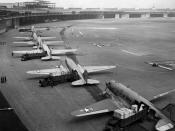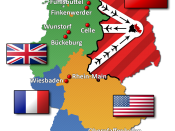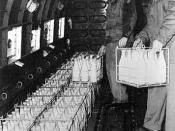A Divided City
World War II nearly wiped out Berlin. About a third of the city was destroyed, and some 152,000 civilians lost their lives. The damage and deaths resulted mostly from Allied bombing raids throughout the war, and from an extended land battle for Berlin. At the conclusion of the war, the victorious allies took over Berlin in 1945 and divided the city into four sectors. Britain, France, the Soviet Union, and the United States each occupied one sector. They also divided Germany into four zones. As stated in the World Book Millennium, "Although Berlin lay within the Soviet zone of occupation; the Western powers expected the Soviet Union to permit them free access to the city. However, in June 1948, the Soviet Union blocked all rail, water, and highway routes through the Soviet zone to the Western sectors of Berlin". The Soviets hoped the blockade would drive Western troops out of Berlin.
The Western Strategy
Gen. Lucius D. Clay, commander of US forces in occupied Germany and Europe announced that no Soviet action short of war would force the Americans out of Berlin. The question was how to make good on that promise, for the Western sectors of the city had a total of less than two weeks of critical supplies, and the small American force in Germany could not have put down the mighty Soviet Army. The British and American forces came up with a strategy to airlift supplies to the sectors of Western Berlin. General Curtis Lemay appointed a committee to make the airlift possible. The British were a little ahead in the preparation for the airlift. The other concerned ally, France, initially distanced itself from this challenge, but only briefly. They had no air transport available in Europe as they were busy with a...



I like
I really like your organization in this. Very well drawn out, and you definitely deserved that grade that you recieved. Thumbs up
2 out of 2 people found this comment useful.